

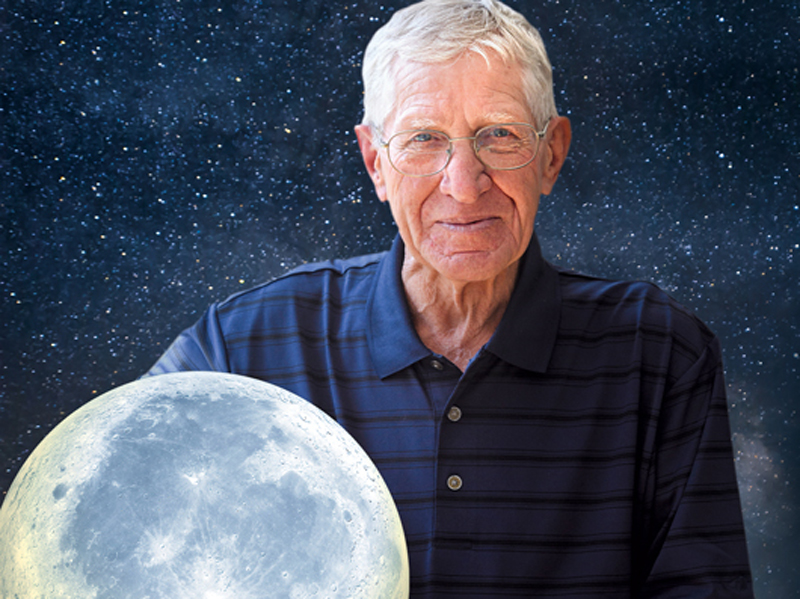
Space suit tailor
Photos by Kathy F. Atkinson and NASA | Photo illustration by Molly Chappell July 15, 2019
UD alum helped Delaware company make Apollo space suits
Editor’s Note: The following story, which appeared in 2017 in UD Magazine, profiles UD graduate Homer “Sonny” Reihm, who led the group at ILC Industries (now ILC Dover) that made space suits for NASA and its Apollo missions. Reihm, now retired, was at Mission Control at NASA’s Johnson Space Center during the Apollo 11 flight.
It was the height of the groovy-but-grim late ’60s, and the collective American consciousness seemed to have lapsed into a dizzy haze, like queasy riders on some psychedelic, psychotic merry-go-round.
In those days, war tore at the nation’s heart, its brutal images countered by flower-power armies. Our cultural aspirations seemed to soar on clouds of illicit smoke, even if miniskirts and music about magic carpet rides were as high as most people got. Everyone seemed eager to consider Timothy Leary’s advice to “turn on, tune in, drop out”—or at least watch wide-eyed as others did.
Not Sonny Reihm. No, he had plenty to keep him busy in those tumultuous times, and a truly cosmic piece of the ’60s dream to chase. As others questioned authority or war, or chased self-enlightenment, he contended with his own challenge, his own big questions.
Questions like: Just how does one protect an astronaut from a mini-meteoroid screaming toward him at 16,000 mph? How should a man dress if he is to survive temperatures as hot as 250 degrees Fahrenheit, and as cold as minus-250? And exactly what does that man wear for a carefree moment singing and skipping on the moon?
This was the ’60s for Homer “Sonny” Reihm, EG60, and his team of workers at ILC Dover: Feeling that occasional punch of dread, knowing men’s lives depended on your work. Sensing that what you were doing, if done without error, would be one of the greatest things to ever emerge from this crazy, beautiful, dangerous decade.
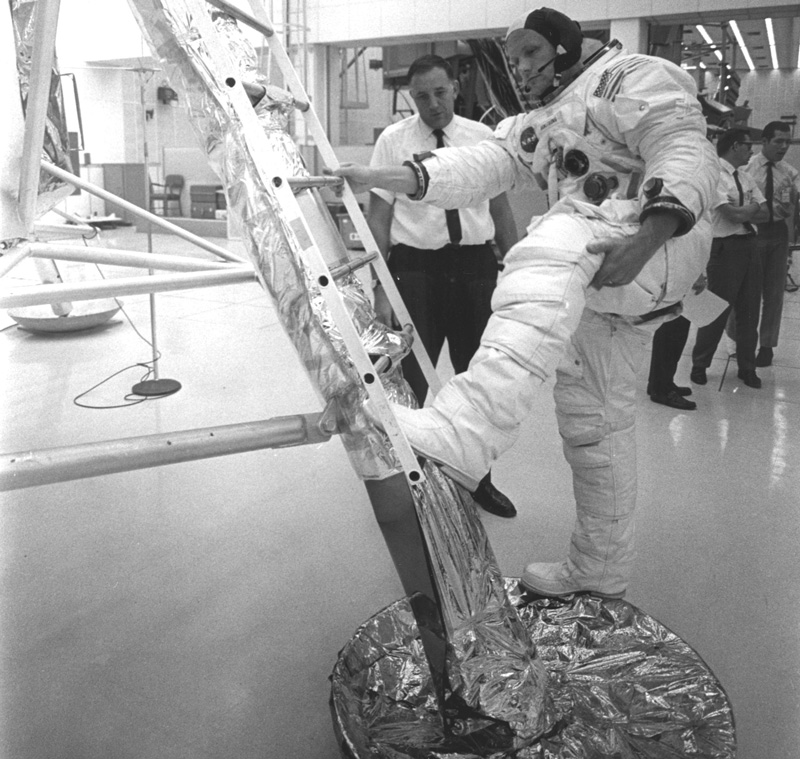
At their factory on the outskirts of Dover, Delaware—a factory that had been known more for making snappy, sexy girdles and brassieres than spacesuits—Reihm and his crew of seamstresses and engineers were deeply proud, and yes a little fearful, of this mission they had volunteered to do: They were going to help put a man on the moon.
At least, that’s what everyone hoped at the time. Nothing much was certain in those heady days of cross-your-fingers determination—rockets blew up, capsules caught fire, the whole space businesses seemed so steeped in imminent mayhem that astronauts were automatically elevated to hero status just for agreeing to try going out there.
But they had experience with such challenges here at ILC. That is to say, they had experience with the technological demands of designing and constructing ladies’ foundational undergarments, which in those days were a physics-defying conglomeration of elastics and fabric, specifically engineered not to fail in un-ladylike ways.
Reihm had arrived as a fresh-faced electrical engineer after graduating from UD in 1960, right about the time the company—widely known to many by its Playtex brand—was venturing into the space market. “That group had a few spaceniks in it,” he recalls. “They had their mind on making a moon suit. And that was before Mercury [the first U.S. space program] even launched.”
In some ways, it wasn’t an unimaginable leap, going from girdle mechanics to moonsuits. In other ways, it’s a breathtaking moment of zero-to-60 acceleration, akin to a manufacturer of bathtubs suddenly declaring it wanted to make battleships.
“Playtex really had a treasure chest of technology,” says Riehm, now 79 and snugly retired amid his collection of moon-shot memorabilia in Dover. The pride he still holds—the memories he treasures—show in his voice. “We did world-class fabrication, and were especially good at rubber-dipping, which is key to making a spacesuit.”
Another key would be ILC’s mastery at making the “convolute”—the flexible, rubber-and-dacron sections of the suit that allowed the astronauts to move their limbs while keeping the suit structurally safe and sound. “Nobody knew how to do that, but Playtex thought they did. The convolute was the key,” Reihm says.
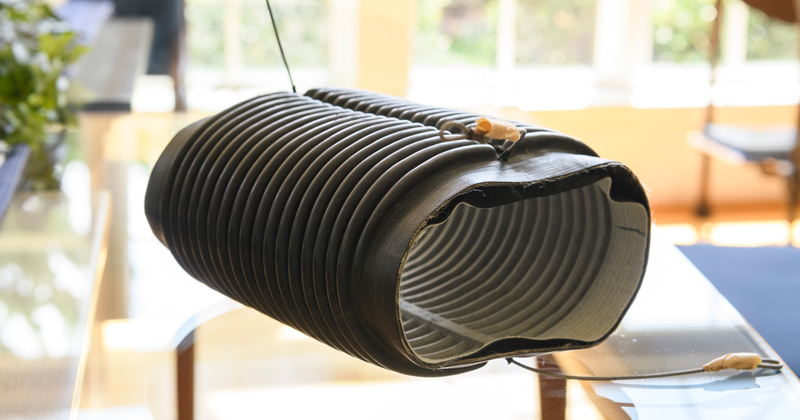
Much of it came about through typically indomitable ILC grit. This is a company, after all, that was nearly bankrupted when World War II broke out and much of its raw material was suddenly unavailable. It would survive by cranking out lifeboats and life preservers for the military, and its owner would vow to never again be caught shortsighted. Managers began closely watching which way government spending might move, always ready to leap. By 1955, with the Soviets looking to the heavens in their quest for a strategic edge, it became clear that some serious space business was on the horizon.
“We’re going to make a moon suit,” Reihm remembers a colleague declaring. “Let’s go for Apollo.”
‘It’s art and science’
Apollo—the program that was conceived to fulfill late President John F. Kennedy’s vow to put a man on the moon by the end of the ’60s—was seen as the last best hope for finally topping the Russians in the space game. At ILC, it was a godsend—a deeply funded program that seemed perfectly paired with its pool of talent: seamstresses who were experts at stitching tight seams; “glue-pot ladies” who could paste fabrics together into a piece capable of surviving the worst of man and nature.
And, as ILC’s Apollo chief project engineer, Sonny Reihm was put in charge of it all.
But first they had to invent the thing they wanted to build. A suit meant for ensuring survival outside of a spacecraft was a relatively new sort of gadget—one that would require airtight construction (so it could be pressurized against the vacuum of space); resistance against the elements (radiation and “micrometeors” among them); and a cooling/heating system capable of managing 500-degree variations in outside temperature. There were also the relatively minor challenges of giving the astronaut something to breathe, installing a system that would allow him to take in fluids, and coming up with some way for him to get rid of them.
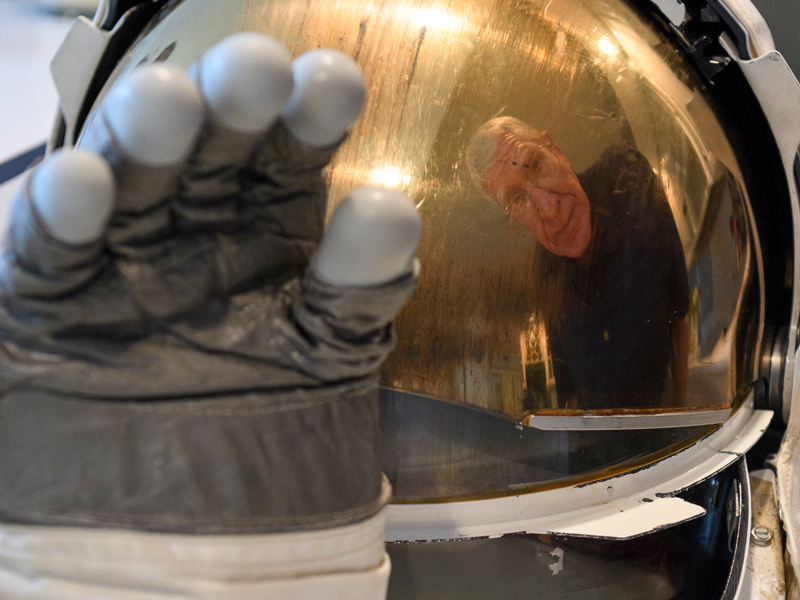
Then there was the not-insubstantial matter of protecting the astronaut’s head—and in the early days, that’s when Reihm’s expertise came in. Soon after he was hired at age 22, he was assigned to test fiberglass flight helmets that were designed for regular pilots flying in less hazardous regions of the sky. But ILC managers quickly saw that the helmet could also be their foot in the door for Apollo and began inching their way toward making the entire suit.
Fortunately, much of the life-support equipment needed could be subcontracted to those firms with special expertise. But that still left the challenge of designing those accordion-tube-like convolutes.
“It’s art and science together,” says Reihm, who would eventually rise to president of ILC. “It took them the better part of three years to make a convolute that was flexible and reliable.”
Much additional brainstorming — much of it by the dozens of UD graduates who would work at ILC — would go into the thousands of components, fabrics, threads and rubber coatings that also go into a suit, which weighs about 240 pounds on Earth, even before a man wriggles inside. Once the suit is built, the astronaut is protected by 20 layers of material—some dipped with exacting precision into molten rubber, others made of material so precious that a square yard of it cost $10,000. Altogether, the suits cost $75,000-$100,000 apiece in 1960s dollars, and ILC had to make 15 for each of the Apollo missions.
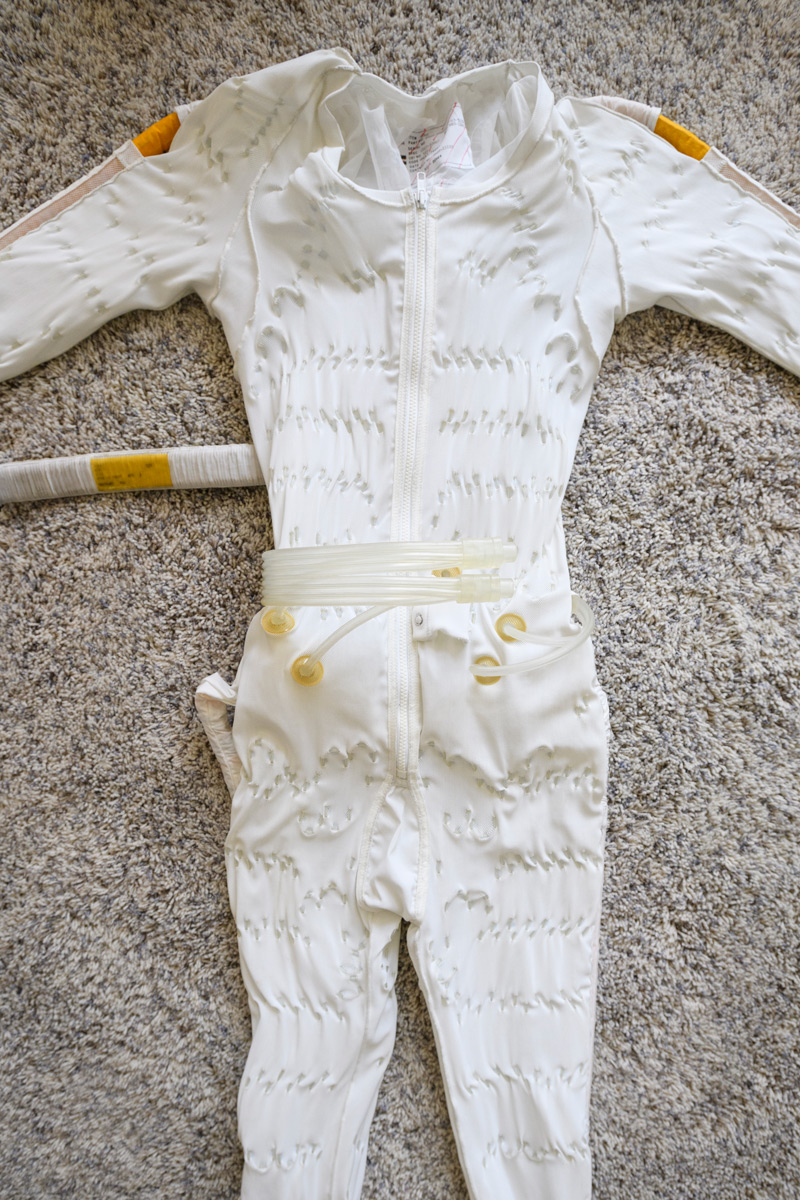
But it was that first suit that had the whole program riding on it. When the prototype was ready, ILC put together a crude video showing a man walking with relative ease in the suit, then sent to film to NASA.
“NASA saw that video, and it was over,” Reihm recalls. “At that point, the contract was ours.”
But for ILC and project leader Reihm, the nail-biting was just beginning. High above the skies of Dover, the moon still shone, still unspoiled by human footsteps. In such an environment, at such a moment in history, would ILC’s tailoring magic work? No one knew—and no one could know—until the astronauts of Apollo 11 landed and threw open their hatch to a new world.
The cowboy rogue
Of course, Reihm’s team had done all they could to forestall any catastrophe. “We had tested that suit like you couldn’t imagine,” he says. “It had to pass simulations representing 20 activities from a typical mission. Apollo 11 is basically the first systems test of the suit. And it’s out there with millions of eyes watching from all over the world.”
About 600 million, to be exact.
On Earth, the suit had been torture-tested in dust chambers, pressure chambers, in jets flying gut-churning parabolic arcs to simulate low gravity. In space, it had to endure the spacewalk of Apollo 9. Astronauts had flown their personal fighter planes in to Dover Air Force Base to get the suits custom-fitted at ILC; one, Dave Scott, had even spent a pleasant evening at Reihm’s home. “I checked in with my wife, Nancy [EHD59], to see if it would be OK to bring him for dinner,” Reihm remembers. “She said, ‘I don’t care who’s coming—we’re having spareribs.’”
But as Reihm sat in Houston mission control during the space flight to the moon, he didn’t imagine glory, or celebrity, or history. He could only think of one thing. “I couldn’t wait for it to get over.”
And his anxiety would only mount as astronaut Buzz Aldrin, clearly swept up in low-gravity exuberance, began bouncing and hopping along the surface. “That silly bastard is out there running all over the place,” Reihm recalls. “And I’m saying, get this crazy guy inside, the mission is over! Buzz Aldrin was a cowboy rogue.”
He would get to know all of those early astronauts well as he guided them through their fittings at ILC, which would go on to supply suits for Skylab and is still making components for spacesuits—along with a host of other high-tech, fabric-based products such as the pillowy bags used to safely “crash-land” the Mars rover.
The mindset needed to embrace such outside-the-box projects was instilled in part at UD, says Reihm. As an electrical engineering student, he had arrived with experience in the vacuum tubes that were used in most electronics of the day—but knew nothing about the more advanced transistor technology that was taking hold in industry. Luckily, his UD professors anticipated the change, he says, and made sure he was prepared for the coming wave.
But, he acknowledges today, nothing fully prepared him or the people at ILC for the ultimate impact of that moment on the moon, and how the image of the bubble-helmeted, space-suited astronaut would become so iconic to the nation.
“We knew as we approached the human landing how big of a deal that was going to be. We knew we were doing something instrumental to the world,” he says. “We never gave up. We worked seven days if we needed to. And, I’m proud to say, we never had a malfunction on a space flight.”
Contact Us
Have a UDaily story idea?
Contact us at ocm@udel.edu
Members of the press
Contact us at 302-831-NEWS or visit the Media Relations website

